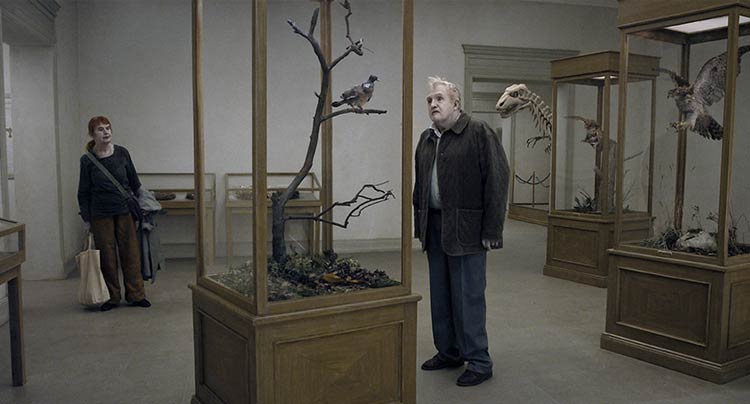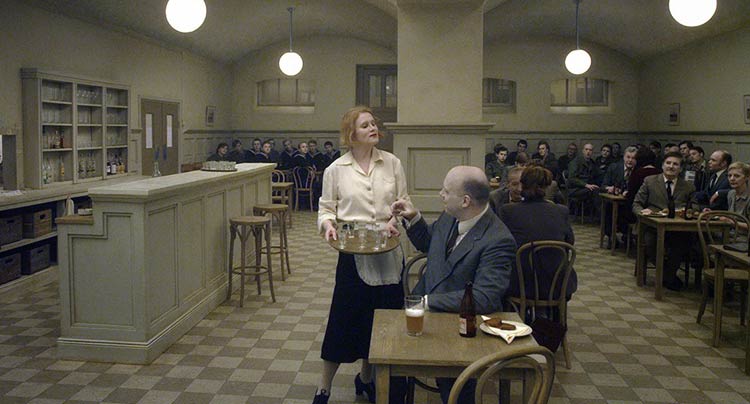
An acerbic punch to the gut and a treasure chest for the philosophically inclined. The work of an auteur on top of his game.

An acerbic punch to the gut and a treasure chest for the philosophically inclined. The work of an auteur on top of his game.
The auteur label is becoming more and more of a taboo, since it implies a belittling attitude towards the hundreds of people working on a given film. In this way, Swedish maestro Roy Andersson is something of a relic; while his movies must be meticulously crafted by hundreds of participants, it’s his inimitable vision that perseveres. He’s got his authorship stamped all over his films, with such surgical precision that you can tell an Andersson film from miles away. It takes the man about 7 years to release a new movie, which has become yet another trait that adds to his auteur status. To call the director anything else feels discrediting. This year, he caps off his trilogy “about being human” with a mouth-watering, mouthful of a title; A Pigeon Sat On A Branch Reflecting On Existence.
The film made Way Too Indie’s Top 15 Most Anticipated TIFF Films, and that was before news came that Andersson walked away with top honors from this year’s Venice Film Festival. As promised on paper, the film is a celebration for cinephiles, and follows in the footsteps of its predecessors; 2000’s Songs From The Second Floor and 2007’s You, The Living. Fans of either of those will fall for A Pigeon the instant it begins. A man walks around a museum, looking at reminders of our futile existence, and reflects on a stuffed pigeon sitting on a branch. Andersson’s impregnable camera lingers on the slightly bamboozled bird until we get three short vignettes thematically connected as “three meetings with death,” each more ridiculous than the last but all equally acidic in their comical disposition.

Along the way, we are introduced to various characters who will cross paths or reappear again in the background. Thanks to Andersson’s definitive choice of having an immobile camera angled with exactness, each scene a single unit with no intercuts, one gets time to scan the screen from top to bottom and left to right, noticing a baby in the corner, or a tearful dance instructor behind the window panes. In this way, Andersson’s cinema is very much made with the spectator in mind; the framework becomes all the richer for it, because there’s a familiarity with the interiors of a café or certain characters, which fill one with unexpected nostalgia. How do you capture nostalgia on film? Roy Andersson knows.
Not all the vignettes work in flawless unity as they do in the previous two installments. But, the ones that don’t interlock seamlessly are the shorter, seemingly more random, ones. Two scenes, running close to 15 minutes (if not longer) in length, are instant classics; a travel back in time to a heavily featured café where a patroness sings a song about paying for shots, and a serendipitous moment when two centuries collide in another café, in the middle of nowhere. These scenes are technical marvels, while simultaneously promoting Andersson’s themes on the human condition, mainly on the subject of war, women’s place in a “man’s world,” and the impact of history on the present.

An assortment of people talking on the telephone and saying how happy they are to hear the person on the other end of the line is doing fine, is one of the comedic underscores and gets a new shade of meaning upon each repeat (whether it’s a woman scrubbing the floors, or another woman in the middle of electro-shocking a monkey). In fact, in its succinct running time of just over 100 minutes, Andersson manages to cram in a wealth of contemplative themes; people’s fear of loneliness, Darwinian principles of survival, society’s dependence on money, and implications behind various commodities, whether they are clown masks or human beings.
A Pigeon is anchored by two of the most often seen characters; a couple of entrepreneurs who walk around trying to “help people have fun” by selling masks and fake vampire fangs. One of them is going through an existential crisis, and at one point listens to the same song on loop, declaring “It’s so beautiful, but so horribly sad too.” That’s as good a description as any of the existence presented in Andersson’s world of beige, powder-white figures. Much like the melancholic 16th century painting “The Hunters In The Snow,” by Pieter Bruegel The Elder, that inspired the film’s title. An acerbic punch to the gut, a comedy of human errors, and a treasure chest for the philosophically inclined; A Pigeon Sat On A Branch Reflecting On Existence is the work of an auteur on top of his game.
Originally published on September 23, 2014 as part of our TIFF coverage